PUMI COLOURS
Part I. Inheritance of colour
More and more breeders and researchers of lesser known breeds with a wide variety of colour find that nature produces dogs with colours that cannot be described with the help of traditional genetic models (like described in the classic works of C.C. Little, O. Winge, A. G. Searle). Indeed, all of these are based on hypothesized gene variations (alleles) with hypothesized dominance order at hypothesized loci to fit data obtained from coat colours and patterns of dogs from various breeds and litters and therefore have their limitations. DNA research has shown that there are more genes involved than those hypothesized and that the actual number of alleles at genes is more for some genes and fewer for other genes than as described by classical models. Furthermore, we now know that all dogs have all genes, though in some breeds the alleles are 'fixed' which means all dogs are homozygous for the same allele, and no other allele will ever appear in the course of breeding. The more coat colours occur in a breed, the more genes will be needed to explain the genotype and phaenotype of the dog because no gene acts in isolation, and there are interactions among the various genes in the pathway so that some colours are not possible unless particular alleles occur at more than one locus.
What is colour? Black or red?
Dogs have a wide variety of genes that influence colour. Further, the same genes may give a very different effect on different types and lengths of coats. However, hair colour is basically determined by melanin.
Melanin is the substance or pigment that gives a dog's hair its colour. There are two distinct types of melanin in the dog: eumelanin and phaeomelanin. Eumelanin is black or dark brown. Phaeomelanin is, in its unmodified form, a yellowish colour.
Melanin is produced by cells called melanocytes. These are found in the skin, hair bulbs (from which the hairs grow) and other places. Melanocytes in the skin are sensitive to UV radiation and normally produce eumelanin. They are responsible for darker exposed skin e.g. nose leather in furred mammals. Melanocytes within the hair follicles cause melanin to be added to the hair as it grows. However, melanin is not added at a constant «rate».
A protein called the Agouti protein has a major effect on the «injection» of melanin into the growing hair. The Agouti protein causes a banding effect on the hair: it causes a fairly sudden change from the production of eumelanin (black/brown pigment) to phaeomelanin (red/yellow pigment).
|
|
|
|
| Black eumelanin B-,E-,K- |
Brown eumelanin bb,E-,K- |
Phaeomelanin Ay-,E-,kk or ee |
Right now, let's look at some of the gene series (loci) known to influence canine colour, and try to get a feel for what they do.
The Agouti Locus (Dominant Red/Yellow) — A gene
The Agouti (agouti signal peptide — ASIP, mapped to dog chromosome 24) locus controls the formation of the Agouti protein, that in turn is one of the mechanisms that controls the replacement of eumelanin with phaeomelanin in the growing hair. The alleles of the Agouti locus can affect not just whether or not the eumelanin→phaeomelanin shift occurs, but also where on the dog's body this happens.
The probable alleles at the Agouti locus, in order of decreasing dominance, are: Ay, aw, as, at and a.
So at the top of the Agouti series then we have Ay, Sable — also known as «dominant red/yellow» or «golden sable». This results in an essentially phaeomelanic phenotype, but the hair tips are eumelanin (black). The extent of the eumelanin tip varies considerably from lighter sables (where just the ear tips are black) to darker sables — where much of the body is dark. It is possible that Ay is not completely dominant over the lower Agouti series alleles, with an Ay heterozygote e.g. Ayat having a darker body. AyAy may be called «clear red/yellow» where as Ayat can be «sabled red/yellow».
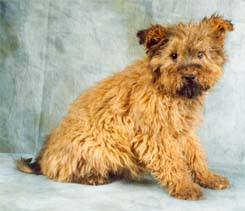
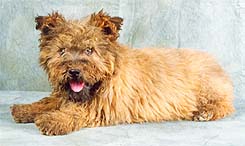
Dominant clear red/yellow pumi puppy with lighter sables, where just the ear tips are black.
Supposed genotype is AyAy,E-,kk
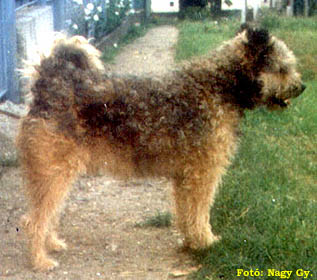
Dominant sabled red/yellow pumi with darker sables, where much of the body is dark.
Supposed genotype is Ayat,E-,kk or Ayas,E-,kk
Next we have aw, «wolf» colour. This is like Ay but the tan is replaced with a pale grey/cream colour and the hairs usually have several bands of light and dark colour, not just the black tip of sable.
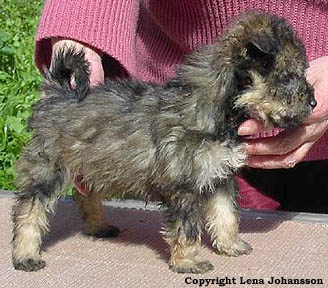
 Wolf-grey coloured pumi puppy with tan marks. Supposed genotype is awat,E-,kk
Wolf-grey coloured pumi puppy with tan marks. Supposed genotype is awat,E-,kk
Moving down the series, the next is as, «saddle tan». This is somewhat like the black&tan allele (below), except that eumelanin is restricted to the back and side regions, hence the name «saddle». It is also possible that this is due to another gene interacting with at/at genotypes.
Allele at, «black&tan» is next. This is a primarily black dog but with tan (phaeomelanin) markings around the eyes, muzzle, chest, stomach and lower legs.
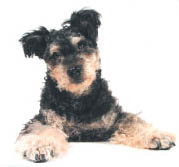
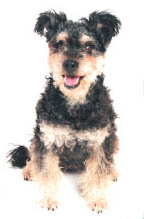
 Black-and-tan coloured pumi. Supposed genotype is atat,E-,kk
Black-and-tan coloured pumi. Supposed genotype is atat,E-,kk
Finally, at the bottom of the Agouti series is recessive black, symbol a. When a dog is homozygous for recessive black (aa), it will have no phaeomelanin in its coat. Examples of breeds that exhibit recessive black are German Shepherd. We also know recessive-black pumis.
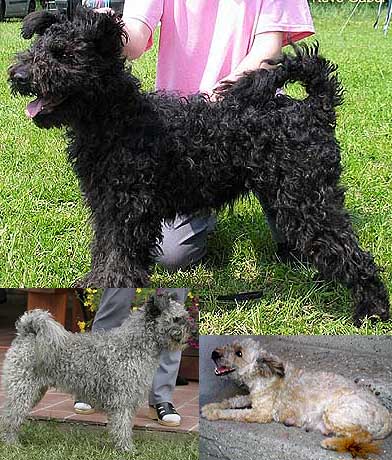
Homoki-Pusztázó Üdvös recessive black pumi bitch (genotype aa,E-,kk)
from the coupling of Homoki-Pusztázó Lármás wolf-grey male (genotype awa,E-,kk) and
Homoki-Pusztázó Jenke dominant sabled red/yellow bitch (genotype Aya,E-,kk)
The existence of all these alleles in the Agouti series is not certain, nor is the precise order of dominance of the intermediate alleles aw as and at.
The Extension Locus (Recessive Red) — E gene
The gene designated as E mapped to dog chromosome 5 is the receptor for Melanocyte Stimulating Hormone (MSH), which is responsible for eumelanin production. This refers to the extension of eumelanin over the dog's body. The dominant form, E, is known as normal extension. The recessive form e, is called non-extension. When a dog is homozygous for non-extension (ee), its coat will be entirely phaeomelanin based — solid red/yellow colour. For this reason this is sometimes termed recessive red or recessive yellow, to distinguish it from the sable reds/yellows generated by the Ay allele at the Agouti locus. ee is epistatic to the Agouti series.
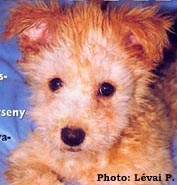
Recessive red/yellow coloured pumi puppy with full expression of dark nose and eye pigment.
There are no black hairs in coat. Genotype is B-,D-,ee.
The (Dominant) Black Locus — K gene
This relative newcomer to the traditional models of dog colour genetics codes for both dominant black and brindle in decreasing order of dominance: K=dominant blacK, kbr=brindle, k=«normal». So a dog that is KK or Kkbr is dominant black, kbrkbr or kbrk is brindled, and kk is «normal (Agouti)». Brindling is the presence of «stripes» of eumelanin-based hairs in areas that are otherwise phaeomelanin based. Dominant black (K) is epistatic to whatever is found at the Agouti locus, however it in turn is overridden by ee at the E locus.
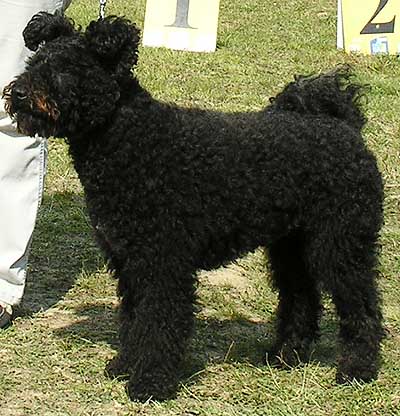
Árkosligeti Kócos Csillag dominant black pumi bich. Genotype E-,K-.
Bringing it Together
It appears that the three loci E, K and A act together as follows:— If a dog is ee at the E locus, its coat will be entirely phaeomelanin based (red/yellow);
— Otherwise (it is Ee or EE at the E locus), if it is K- at the K locus its coat will be entirely
eumelanin based (dominant black);
— Otherwise (it is Ee or EE at the E locus), if it is kbrkbr or kbrk
at the K locus it; will be brindled with the colour of the phaeomelanin part of the brindling in
turn affected by the Agouti alleles present;
— Otherwise (it is Ee or EE at the E locus, and it is kk at the K locus), the distribution
of eumelanin and phaeomelanin will be determined solely by the Agouti alleles present.

2003—2007 © Länger Tamara
© Photos courtesy of Olajos Andrea, Dogheart, Nagy György, Lena Johansson, dr.Lévai Piroska, ALEX, Keve Gábor, Jade Lastikka
Sourses:
László Zöldág. «Canine genetics and hereditary diseases», 1996
László Zöldág. «Canine breeding and health protection», 1998
Malcolm B. Willis BSc PhD. «Genetics Of The Dog», 2000
E. Jerusalimskiy. «Canine exterrior and qualification», 2002
Tenset tech. Ltd. «Canine genetics primer and canine genetics software»
Schmutz, Shelia M. «Genetics of coat color and type in dogs»